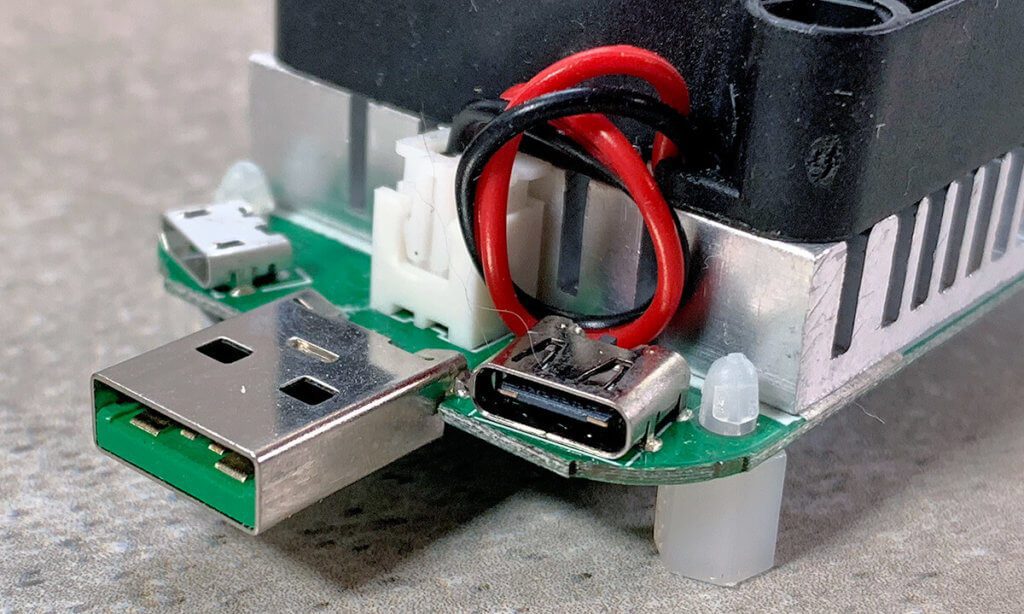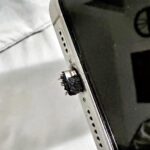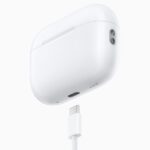In my power bank tests, like recently the one Charmast power bank, a USB load resistor is used regularly. In this article I would like to explain to you what kind of thing it actually is and what - in my case - the purpose is. If you like abbreviations like mAh, Wh and the like already gets a headache, I can reassure you: I try very hard that the article is also understandable for electrical laypeople.
Note: I am not an electrical specialist and have only taught myself these things. Please forgive me if there should be one or the other technical error in the article. If you let me know, I'll be happy to correct it.

Chapter in this post:
- 1 A load resistor simulates an electrical consumer
- 2 Electrical energy is converted into heat
- 3 My purpose: Controlled discharging of power banks
- 4 Small shopping advice for USB load modules
- 5 My next test model: 200 W load resistance
- 6 USB-C load resistors with Quick Charge and USB PD
- 7 Update 04.04.2020/XNUMX/XNUMX: USB PD Tester on AliExpress
- 8 Similar posts
A load resistor simulates an electrical consumer
Load resistors are not only used in connection with the USB connection, but also in other areas. They make it possible to simulate a consumer - as a device that consumes electricity - whose properties can even be adjusted.
That means I can adjust the power the resistor uses with a regulator to make it work as a constant current load. In the model I use, you can see two potentiometers, which I can use to make a rough and then a fine setting of the current intensity. Since the USB-A port always has an output voltage of 5 volts, the calculation of current times voltage results in the electrical power (I * U = P) that is consumed.

Electrical energy is converted into heat
Now you may be wondering what the load resistance does with all the energy that is in such a power bank. The answer is simple: it converts it into heat and gives it off to the environment. For this reason, you will also find a thick cooling plate and one on my load resistor Fan, which starts when the temperature of the electronics exceeds a certain level.
My purpose: Controlled discharging of power banks
There are certainly many applications for USB load resistors, such as a stress test of the electronics that supply the port, as well as testing USB power supplies that are to be tried out with different loads.

In my case, however, the aim is to completely discharge power banks for the tests and to use a USB multimeter to measure how much electrical energy they can emit in total. You could also do this by plugging in an iPad for charging, but unfortunately the larger power banks manage to fully charge the iPad without being empty themselves. That doesn't help me for the tests.
Ok, sometimes I also use the USB load resistors to measure the power at which power banks or USB power supplies switch off. This happens when you draw too much power and the internal electronics deactivate the outputs for safety reasons. To find this point, I connect the load resistor to the power supply unit or the power bank and then slowly increase the power until it switches off - or, in the case of particularly powerful power supplies, until an unpleasant smell of the circuit board is too hot.

Small purchase advice for USB load modules
In the meantime I have already bought some of these USB load resistors and also killed one or the other through these stress tests. Ultimately, however, there is only this one modelthat I can really recommend:
- Multifunction: This electronic load can measure voltage, current, capacity, energy, power and timing in real time ...
- Input interface and output interface: USB input; clip-wire interface; socket with ...
- Attractive design: With a high-quality aluminum heat sink in the middle for better heat dissipation
Unfortunately, it is impossible to name a manufacturer, as these devices come from China and the dealers change every few weeks. You can recognize it from the photos: There are two silver controls on the circuit board, plus a cooling plate and a small fan - see photo.
The other models that I used were all broken either by cold soldering points at the connections or by a defect in the electronics.
My next test model: 200 W load resistance
If I had to buy a new constant current load module right now, I probably would dieses hier because it can handle an enormous amount of power (up to 200 W - nonsensical with USB, but nice to have) and can therefore also be used for powerful power supplies. However, you have to like that the connections are provided with cable clips:
No products found.

USB-C load resistors with Quick Charge and USB PD
Since I always have USB-C power supplies with me USB Power Delivery fluttering in, it would be nice to have a constant current load that can handle the higher voltages from USB PD and has a USB-C port.
There is though here a device, which can be connected with USB C and even supports Qualcomm QuickCharge 2.0 and 3.0, but unfortunately no Power Delivery, which would be the appropriate standard for Apple devices:
No products found.
If you know a provider who offers a load resistor that supports the USB PD protocol, then I would be happy to receive a short comment.

Update 04.04.2020/XNUMX/XNUMX: USB PD Tester on AliExpress
After the tip of my reader Raffi (thanks!), I did some research on AliExpress and I'm on the USB tester “UD18L” encountered. This device is a combination of a USB multimeter and a USB load module. The special thing about it: According to the product description, it also supports USB Power Delivery with voltages of up to 20 volts and an output of 65 watts. You can't charge a thick MacBook Pro power supply with it, which is now 85 or 96 watts. Most of the USB C power supplies that I have tested so far can, however, be loaded to the limit.
I haven't ordered the device yet, but I think it will load into the shopping cart the next time I go to AliExpress. Then I can tell you how it fares in the practical test.
Related Articles
Jens has been running the blog since 2012. He acts as Sir Apfelot for his readers and helps them with technical problems. In his spare time he rides electric unicycles, takes photos (preferably with the iPhone, of course), climbs around in the Hessian mountains or hikes with the family. His articles deal with Apple products, news from the world of drones or solutions to current bugs.
The page contains affiliate links / images: Amazon.de










Exciting topic (didn't even know until now that there was such a thing) and good presentation! Many Thanks!
With pleasure! But you are probably one of the three readers that the article interests. : D
Hoi Jens, if you tell me what voltages and maximum currents you want to process, I can solder such a part together for you. LG
Hello Micah! That's a great offer. With USB PD, the consumer "orders" the voltage and says what he can handle. If you can get the self-soldered load resistor to do that, that would be great. These are then the voltages 5, 9, 12, 15, 20 volts. Outputs of up to 100 watts should be possible. I think that's quite something for the electronic consumer to do, right?
Get another device like this: https://de.aliexpress.com/item/32880908871.html
Then you can measure directly: power bank / power supply-> multimeter-> load.
There you can see directly where the power bank / power supply comes out and it also records graphs. If you want to know more, write me an email!
Greetings Raffi
Hello Raffi! Thanks for the tip. The thing is ordered. Let's see what the iPhone app is good for. : D I think there will be a test report about it, if it is not total crap. : D
So I don't know the app, mine doesn't have one yet. But it is not junk, perfect for testing whether a USB power supply unit makes a permanent 2A or something similar. Many give up quickly. Also good for testing cables, as I said, feel free to contact us.
Hello Raffael! Yes, I will be in contact! : D I'm interested in the cable test. ;-)
I think there are a few more interested readers! ;-)
Especially those who, like me, are a little more interested in the functionality of the hardware and test processes!
Well, then I like to throw in such a contribution every now and then and share my extensive half-knowledge. :-P
Greetings Sir Apfelot!
Have you already tested the USB tester “UD18L”? Unfortunately, I didn't find anything about it (maybe my research methods are too bad...). ;-)
I'm looking for something like this and it's really difficult to find electronic loads that are PD capable...
Hello Andy! I've just looked in my box, but the UD18L already seems to be with the e-waste. I have three more such loads here, but they all look different than the UD18L on eBay. I would recommend you the following, which I have been doing for 1-2 years: I have me such a USB multimeter with USB-C PD Bought one and attached it USB-C PD power bank, which I charge. It's the resistance, so to speak... unfortunately not adjustable, but you can see whether it switches to USB C PD or not.
aahh!
That's right, I have a whole bunch of 27000 mAh power banks from Hama. They draw 30W when charging. Then I really only need a PD meter. And then you can at least see what voltage they agree on (20V/1.5A or 15V/2A etc.) Thanks for the tip!
Yes, you see voltage, current and power. And even the wh and the time.